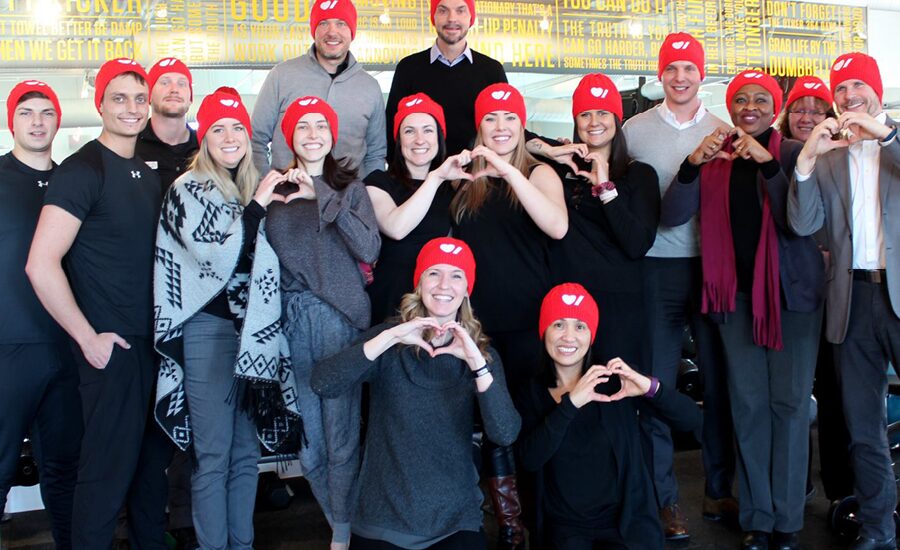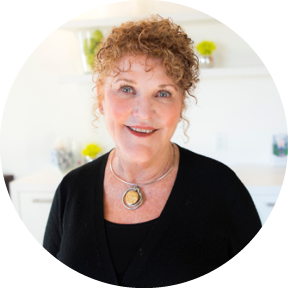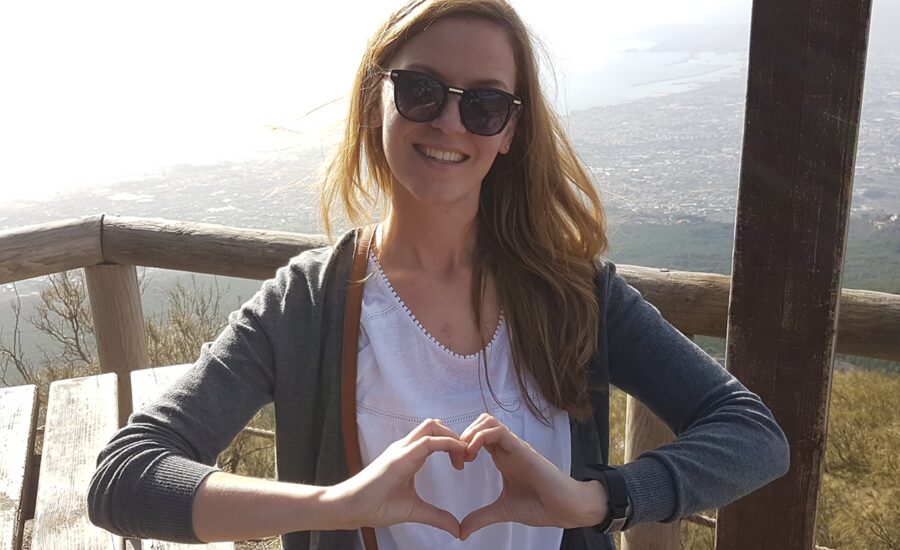Part 3 of 3.
One of our INLIV teammates, Jennifer Michaud, shares her heart story in this three-part series. Read Part 1 and Part 2.
My husband told me afterwards that my surgery took longer than anticipated by about an hour, which caused a lot of anxiety for him and my parents. My surgeon advised them afterwards he had been shocked by how enlarged my aortic root was (where the aorta attaches to the heart), a sign of my heart working overtime to accommodate my ineffective aortic valve. He needed that extra time to ensure my new bio-prosthetic valve would fit and remain in place.
After my surgery I was moved to the Cardiovascular Intensive Care Unit, or CVICU for monitoring and recovery, and my family was allowed in to see me and sit with me.
I don’t really remember waking up for the first time, but I do have memories of wakefulness during the first few hours. I had a breathing tube in place, was exhausted, in pain, and on a lot of medication.
But that same afternoon, after they had removed the tube and I was more awake and aware, the CVICU nurses got me up on my feet, and I walked around the unit for maybe 30 seconds. I was told before the surgery that it would be incredibly important to get up and get moving as soon as possible, to help prevent blood clots post-surgery, and that’s exactly what they had me do.
I also had to practice deep breathing and coughing at regular intervals, to help keep my lungs clear of pneumonia. I was given a heart-shaped pillow to hold to my sternum as a sort of brace during these efforts. I needed that brace because my surgeon had performed an upper hemisternotomy: he cut open the upper half of my sternum, from about mid-point in my chest to my clavicle and pulled my rib-cage apart in order to access my heart and aortic valve.
Once the procedure was completed, he pulled my sternum back together and secured it with stainless steel wires – at least four that I can still see and feel under my skin, but thankfully they don’t bother me. Considering the damage done to my sternum, coughing without some sort of support would have been extremely painful – as it was, it was no walk in the park. But I was committed to getting better and getting out of the hospital and back home, so I walked and coughed whenever the nurses asked me to.
On Sunday, two days after my surgery, I was transferred to the telemetry, or step-down, unit. This area is still meant for high observation, but less than the ICU. I was actually able to walk there myself – it was only down the hall (on the same floor of the CVICU), but I remember feeling proud to be able to do it.
Once in the step-down unit I made more progress each day. I was awake for longer periods of time, went on multiple short walks a day around the unit, and ate solid foods again. On the day before I was released, I was asked to walk up and down a flight of stairs under the observation of a physiotherapist (important for me because my house has stairs). Being able to do so unassisted was the final signal for my medical team that I was ready to be discharged. My husband took me home on the morning of May 25th, five days after my surgery.
I want to take a moment now to say just how incredible the nurses were at the Foothills Medical Centre Cardiovascular Unit. I have never met a more compassionate, empathetic and wonderful group of human beings; they helped comfort me when I was feeling my worst, and lifted me up (sometimes literally) to move forward into my recovery. I am endlessly grateful to them, and to my cardiac surgeon and the whole surgical team; I can never repay them for all they did for me.
I remember clearly the day, within that first week of being home, that we went on a walk to the end of our block – maybe 60 metres. The sun was shining, the weather was warm and my husband was visibly proud of me; it’s one of my favourite memories of that time.
Upon arriving home, my first thought was that I needed a shower. The nurses in the hospital did a wonderful job of keeping me as clean and comfortable as possible, but there is nothing like the feeling of a warm shower after almost a week in the hospital.
I remember my parents and my husband and I sitting at my kitchen table afterwards and chatting like it was any other normal day; it was a wonderful way to be welcomed home. My parents left for their own home soon after, and my husband was able to take time off work to be with me for the first few weeks (Mom would come back to stay and help out when he went back to work).
My memories of the first month or so post-surgery sort of muddle together. My husband tells me I had a hard time getting comfortable wherever I was sitting or lying, but I still managed to sleep a lot. One of the snippets I remember clearly was the day, within that first week of being home, that we went on a walk to the end of our block – maybe 60 metres. The sun was shining, the weather was warm and my husband was visibly proud of me; it’s one of my favourite memories of that time.
From small things like making lunch for myself or styling my hair, to doing the laundry, going out to a restaurant or walking around my neighbourhood unsupervised – the process of getting back to normal life was marked by many different levels of goals and achievements.
After the surgery, I did a lot of things for the first time again, and they became pretty big milestones. From small things like making lunch for myself or styling my hair, to doing the laundry, going out to a restaurant or walking around my neighbourhood unsupervised – the process of getting back to normal life was marked by many different levels of goals and achievements.
To further support my recovery, I participated in a Cardiac Rehabilitation program at the Repsol Sport Centre. I was enrolled in this free program through the team at the hospital to receive classroom-style education about heart healthy living and coaching for gym or at-home exercise programs.
On September 1, I returned to work. At this point, I was almost entirely recovered. I still had soreness in my chest muscles and would get overly tired after a full days’ work, but yoga and the ongoing routine of office life helped with those symptoms.
On the first anniversary of my surgery, my husband and I went out for brunch. It meant the world to me to be able to enjoy my favourite meal with my favourite person one year after the fact. Instead of me lying in a hospital bed, we were sitting on a patio with coffee and waffles, talking and laughing and planning the rest of our weekend.
That same year we took a long awaited trip to Italy and visited Rome, Venice and – from my personal bucket list – Pompeii. I was able to walk longer each day and enjoy more sights than I would have thought possible.
Though I consider myself fully recovered now, this experience has changed me.
And two years after my surgery, I happily sang and danced my way through another musical theatre production.
Though I consider myself fully recovered now, this experience has changed me. I tend to sleep heavier (apologies to my husband for my snoring), have issues with my memories around the time of the surgery and recovery, and view my own life’s calendar in terms of “Before” and “After” open-heart surgery. As much as I initially wanted it to fade away and into the background of my psyche some days, it wouldn’t.
And now I find myself glad it didn’t. Like any sort of trauma, I have had to learn to accept it, live with it, and even embrace it. I am grateful for the experience, because it has helped to shape the person I am today. I am grateful for being given the chance to see true selflessness and compassion, from my husband, my family, my medical team, my friends and coworkers.
I now enjoy volunteering with the Heart and Stroke Foundation, in an effort to give back to the community who rallied around me in my time of need. Over the past 60 years, thousands of lives have been saved and millions more improved thanks to their efforts as a leading funder of life-saving research.
Stay on top of your health, know your risk factors, ask for second opinions, make healthy living choices on a daily basis, and consider yourself worth the time or cost it takes to go see your doctor regularly. Take care of yourself now, so you can live your best life for as long as possible.
If you take only one thing from my story, I hope it is this – be your own health advocate. We have an amazing healthcare system in Alberta to get you help when you need it, but you have to know when to ask for that help, and you have to be willing to do it. Stay on top of your health, know your risk factors, ask for second opinions, make healthy living choices on a daily basis, and consider yourself worth the time or cost it takes to go see your doctor regularly. Take care of yourself now, so you can live your best life for as long as possible.

Concerned about your heart health? INLIV can help.

“It is important to be proactive when it comes to your health: seek advice when noting new symptoms and get help early; know your numbers such as blood pressure, BMI, cholesterol levels and be an active participant in your own healthcare.
Our Total Health Management program is an excellent primary care program that can help support your ongoing health needs. We also have a Proactive Health Assessment program that can offers health screening and provides you with a snapshot of your health with recommendations for preventive care.“
– Dr. Wendy Smeltzer, Medical Director at INLIV


